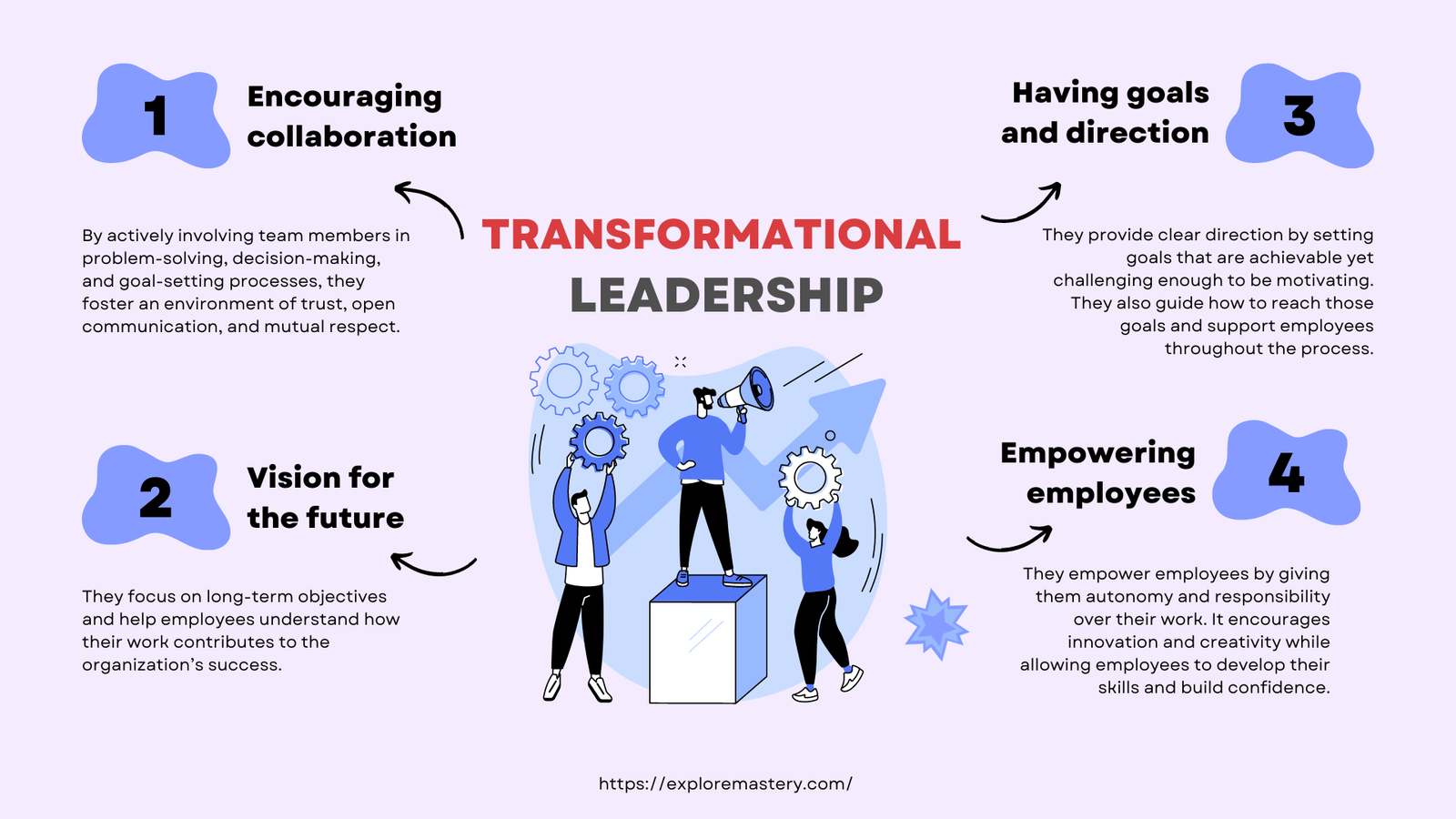Understanding leadership styles is crucial in management. Transformational Leadership is one of the well-identified types of leadership and an inspiring way of leading that encourages others to make positive changes in their lives and work. This blog post will show examples of transformational leaders who have impacted their organizations and the people around them.
What is Transformational Leadership?
Transformational Leadership is a leadership style that focuses on developing relationships, motivating others, and inspiring people to reach their full potential. It involves creating a shared vision and setting goals that inspire, motivate, and energize employees. Transformational leaders use their passion and enthusiasm to create a positive work environment and develop strong relationships with their team members. They also recognize and reward good performance, provide direction and feedback, hold themselves accountable for results, and empower employees to take the initiative. Transformational Leadership has been shown to effectively motivate employees, increase productivity, and achieve desired outcomes.

How to Use Transformational Leadership – Examples of Transformational Leadership
Transformational Leadership is a powerful and effective way to motivate and inspire your team. It is based on the idea that by providing a clear vision, setting achievable goals, rewarding good performance, and encouraging collaboration and cooperation, leaders can create an environment where everyone is motivated to reach their fullest potential. To use transformational Leadership effectively, here are some key strategies:

Encouraging Collaboration and Cooperation in the Workplace: Transformational leaders create an atmosphere of collaboration and cooperation. By actively involving team members in problem-solving, decision-making, and goal-setting processes, they foster an environment of trust, open communication, and mutual respect.
Creating a Vision for the Future: Transformational leaders strive to provide a clear vision for the future and set achievable goals to help their team reach it. They focus on long-term objectives and help employees understand how their work contributes to the organization’s success.
Setting Goals and Providing Direction: Transformational leaders provide clear direction by setting goals that are achievable yet challenging enough to be motivating. They also guide how to reach those goals and support employees throughout the process.
Empowering Employees to Take Initiative: Transformational leaders empower employees by giving them autonomy and responsibility over their work. It encourages innovation and creativity while allowing employees to develop their skills and build confidence.
Encouraging Collaboration and Cooperation in the Workplace – Examples of Transformational Leadership
Collaboration and cooperation are essential components of successful teamwork. Transformational leaders understand the importance of fostering a culture of collaboration and cooperation in the workplace. They ensure that teams work together productively and effectively. Transformational leaders strive to create an environment where all team members can contribute their skills and expertise. They also encourage their team members to solve problems, brainstorm ideas, and develop innovative solutions. Transformational leaders emphasize the importance of collaboration and cooperation in the workplace and provide the necessary resources and guidance to ensure that everyone is working towards a common goal. By encouraging collaboration and cooperation in the workplace, transformational leaders promote a culture of camaraderie, trust, and respect between team members.
Creating a Vision for the Future – Examples of Transformational Leadership
Creating a vision for the future is vital to successful transformational Leadership. Leaders need to clearly understand where they want the organization to go and how to get there. It is important to provide employees with a sense of direction and purpose to keep them motivated and engaged. Transformational leaders can create a vision that inspires and motivates their team to follow it. Transformational leaders who have successfully created a vision for the future include Mary Barra, Steve Jobs, Jeff Bezos, and Bill Gates. These leaders have achieved remarkable accomplishments by setting clear goals and providing direction. Mary Barra was able to turn General Motors around and double its profits in just a few years. Steve Jobs revolutionized the world with Apple’s groundbreaking products; Jeff Bezos transformed how we shop with Amazon. Bill Gates created a technology empire with Microsoft. These are all examples of how transformational leaders can create a vision for the future that drives success.
Setting Goals and Providing Direction – Examples of Transformational Leadership
Setting goals and providing direction are essential components of Transformational Leadership. Leaders must clearly articulate their vision to employees and align their goals with the company’s objectives. Successful transformational leaders can ensure that everyone understands their tasks’ purpose and importance and helps them stay motivated to achieve the desired results. Leaders should also provide timely feedback to encourage their team members and ensure they stay on track. Examples of transformational leaders who have successfully set goals and provided direction are Steve Jobs, Mary Barra, Jeff Bezos, Bill Gates, and Reed Hastings. Steve Jobs was known for setting ambitious goals for Apple and inspiring his employees to reach them. Mary Barra was able to turn around General Motors by setting clear goals and providing direction for the company’s future. Jeff Bezos is renowned for his ability to set challenging goals for Amazon and empower his team members to pursue them. Bill Gates achieved unprecedented success with Microsoft by providing clear direction for the company’s growth. Reed Hastings has transformed Netflix into a streaming entertainment giant by setting goals and providing direction that aligns with the company’s vision.

Empowering Employees to Take Initiative
Empowering employees to take the initiative is one of the key aspects of transformational Leadership. It involves providing employees with the autonomy and trust to make decisions and take risks. Leaders can create a more engaged workforce motivated to learn, grow, and succeed by empowering employees. Leaders should provide guidance and support while also setting boundaries and expectations. They should ensure that employees have access to the resources and information they need to make informed decisions. Leaders should also recognize and reward employee efforts, increasing their motivation and sense of empowerment. By empowering employees, leaders can create a culture of collaboration, innovation, and growth within their organization.
Inspiring Others Through Passion and Enthusiasm
Transformational leaders are known for their ability to inspire and motivate others with enthusiasm and passion. This type of Leadership has been demonstrated by some of the most successful leaders in history, such as Oprah Winfrey, Steve Jobs and Nelson Mandela. By leading with passion and enthusiasm, transformational leaders can create a sense of purpose among their team members, leading to higher productivity and better results.
Oprah Winfrey is a transformational leader who inspires others with enthusiasm and passion. She is an iconic figure in the media industry, renowned for her ability to bring people together through her talks and interviews. Winfrey has also used her platform to raise awareness about important social issues and create positive societal change.
Steve Jobs is another example of a transformational leader who inspired others through his passion and enthusiasm for Apple. Jobs was known for his innovative ideas and determination to see them through, which motivated his team to take risks and think outside the box. His leadership style enabled Apple to become one of the world’s most successful and profitable companies.
Nelson Mandela is a prominent example of transformational Leadership due to his unwavering commitment to his cause. He was passionate about creating a better future for South Africa, and his enthusiasm was infectious. His leadership style inspired millions of people around the world to fight for freedom and justice.
Transformational leaders can bring out the best in their teams by inspiring them
Building Relationships With Your Team Members – Examples of Transformational Leadership
Building strong relationships with your team members is one of the key aspects of transformational Leadership. It is important to take the time to get to know your team members personally and understand their strengths and weaknesses. Doing this can create an environment of trust and mutual respect, which can help increase productivity and foster collaboration. When team members feel valued and appreciated, they are more likely to be engaged and motivated to do their best work. As a leader, it is important to recognize the value of each team member and strive to create an open and supportive culture in which everyone can express their ideas and feel heard.
Fostering Open Communication and Feedback – Examples of Transformational Leadership
Fostering open communication and feedback is an important part of transformational Leadership. Leaders need to be willing to listen to the ideas and suggestions of their team members, as well as provide constructive criticism to help them grow and develop. This level of communication can help create a more trusting environment between the leader and their team while encouraging collaboration and cooperation. Leaders need to be willing to take the time to actively listen to all team members and provide honest and constructive feedback to improve their performance. By doing so, they will create an environment of respect, trust, and collaboration that will help foster creativity, innovation, and productivity within the workplace.
Taking Care of Your Team’s Well-being – Examples of Transformational Leadership
Taking care of your team’s well-being is essential for successful transformational Leadership. It means ensuring they have the necessary resources, support, and recognition and providing a safe and healthy work environment. Leaders should be aware of any challenges affecting their team’s morale, such as burnout or stress, and take steps to ensure their team is supported and can be successful. Leaders should also be open to feedback from their team and allow them to speak up if they have any concerns. Recognizing and celebrating successes is also important, as this can boost morale and show your team that you value their hard work. By taking care of their well-being, you can create an environment where your team can thrive and be productive.
Rewarding Good Performance – Examples of Transformational Leadership
Rewarding good performance is a key part of transformational Leadership. By recognizing and rewarding individuals and teams for their hard work and dedication, leaders can help motivate their teams to strive for success. It can be done through tangible rewards such as bonuses or promotions or more intangible acknowledgments such as praise or recognition in front of the team. Rewarding good performance also helps strengthen relationships between leaders and their team members, creating an environment of mutual respect and trust. By providing rewards for excellence, leaders can help their team members stay motivated and committed to meeting their goals.
Holding Yourself Accountable For Results
Holding yourself accountable for results is an important part of being a successful transformational leader. Leaders need to demonstrate the qualities they expect from their team and take responsibility for their mistakes. As a leader, you should clearly understand your team’s goals and objectives and be prepared to work with your team members to achieve them. It would be best if you were willing to accept criticism and learn from your errors. By holding yourself accountable, you can set an example of transparency, integrity, and responsibility that your team can follow.
Many examples of transformational leaders have held themselves accountable for results. Oprah Winfrey is a great example of someone who has taken responsibility for her success and used it as a platform to mentor and inspire others. Steve Jobs was another leader who held himself accountable, consistently pushing himself and his team toward greater heights. Mary Barra, the CEO of General Motors, is also an example of someone who has held herself accountable for her company’s success, leading them through a turnaround and doubling its profits in a few years. Jeff Bezos is yet another example of holding himself accountable for his company’s success – his vision and Leadership have made Amazon one of the leading companies in the world. Finally, Reed Hastings, the CEO of Netflix, is an example of someone who has held himself accountable for transforming the streaming entertainment industry.
Examples Of Transformational Leaders In Action
Transformational leaders have a way of inspiring others to take action and achieve greatness. They are passionate and enthusiastic about their vision and can effectively communicate it to their team. Through their example, they spark creativity and innovation in the workplace. Here are some examples of transformational leaders in action:
Oprah Winfrey: The media mogul is famous for her charismatic, visionary, and inspirational leadership style. She has used her platform to empower people worldwide by encouraging them to believe in themselves and take charge of their lives.
Steve Jobs: Jobs was famous for his visionary Leadership that transformed Apple into a leader in the technology industry. He encouraged collaboration and creativity among his team members and was passionate about creating innovative products.
Mary Barra: The CEO of General Motors, Mary Barra, is an example of a successful transformational leader. Under her guidance, she led the company through a major restructuring, resulting in increased profits and improved customer satisfaction.
Jeff Bezos: The founder of Amazon, Jeff Bezos, is known for his strategic vision and ability to think long-term. He encourages his team to challenge the status quo and take risks to innovate and create new solutions.
Nelson Mandela: The iconic leader is known for his unwavering commitment to justice and equality in South Africa. He inspired a nation through his passion and energy, using his platform to promote peace and reconciliation among different people groups.
The Benefits of Transformational Leadership
Transformational Leadership can offer numerous benefits to both the organization and its employees. It can create an empowering and collaborative environment while helping to build strong relationships between team members. It can also foster a sense of ownership in employees, allowing them to take the initiative and develop their ideas. Additionally, it can help to set clear goals and provide direction and support while inspiring passion and enthusiasm in the workplace. Transformational Leadership helps to develop a shared vision for success while encouraging collaboration and cooperation among team members. By taking care of the well-being of its employees and rewarding good performance, it can help to create an engaged and motivated workforce that is dedicated to achieving its goals.
Conclusion
Transformational Leadership is a powerful tool that can help organizations and teams reach new heights of success. By understanding the principles of transformational Leadership, managers can use them to create an environment of collaboration, innovation, and motivation among their team members. By setting a clear vision, providing direction and support, and rewarding good performance, transformational leaders can inspire their teams to achieve extraordinary results. Examples of successful transformational leaders such as Oprah Winfrey, Steve Jobs, Mary Barra, Jeff Bezos, and Nelson Mandela have shown us how powerful this leadership style can be. As a manager, use these examples as a source of inspiration and guidance to help you become the best leader you can be.



